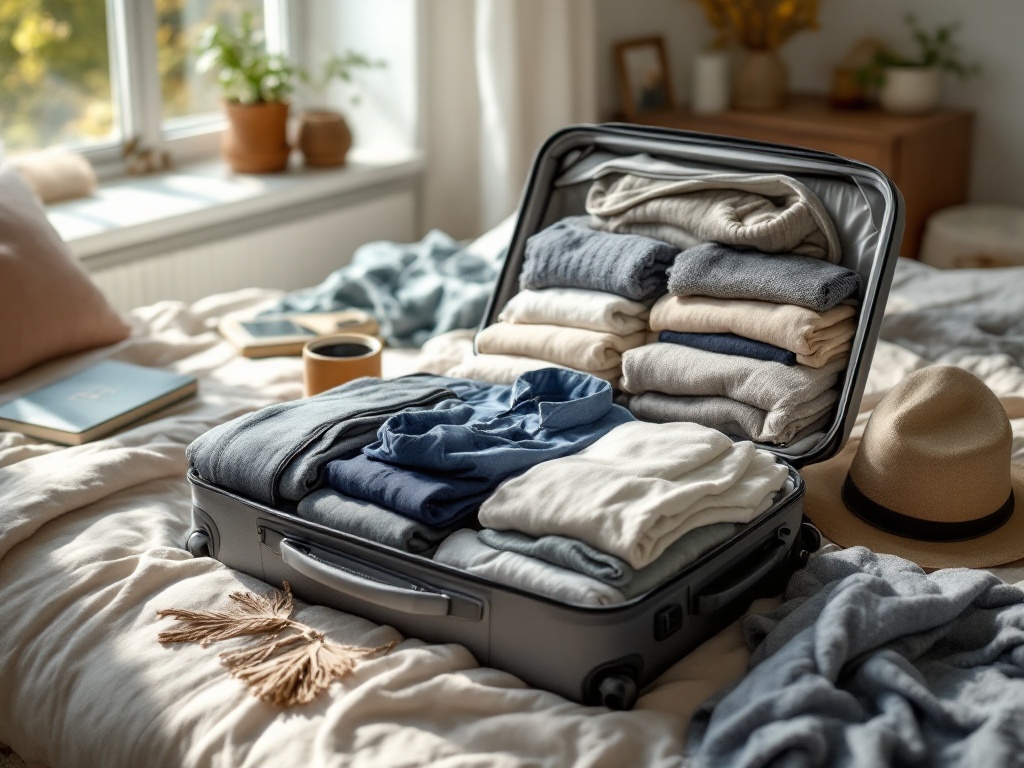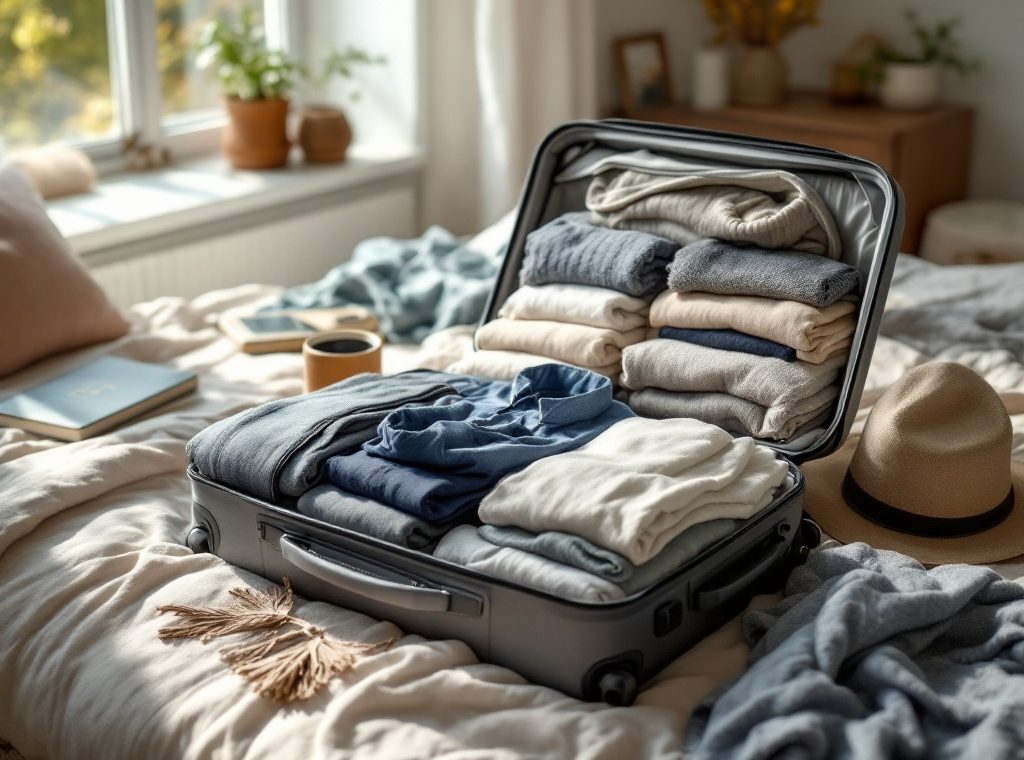What to Pack for Different Climates: A Comprehensive Guide
Dream of traveling light, no matter the weather? Learn to pack efficiently for any climate! Discover how to research destinations, create capsule wardrobes, and choose versatile, multi-functional clothing. Master the art of layering and explore essential fabrics like merino wool and linen. We’ll cover must-have accessories and smart packing tips using packing cubes. Start your journey to stress-free travel now!
Important information

- Research the climate of your destination and check the forecast before you leave.
- Pack versatile, neutral-colored clothing items that can be mixed and matched.
- Use packing cubes to organize clothes and save space.
- Layer clothing with a moisture-wicking base, insulating mid-layer, and weatherproof outer shell.
- Choose breathable fabrics like merino wool, linen, or cotton and avoid heavy synthetics.
Introduction to Packing for Different Climates
Research your destination’s climate to pack efficiently for all weather conditions.
Create a comprehensive packing list to ensure you have all the necessary items.
Pack appropriate outerwear and remember the importance of layering for warmth.
Use packing cubes to organize clothes by climate and save valuable luggage space.
Prioritize versatile clothing items like a light jacket that can be layered or worn alone.
Double-check the weather forecast right before departure for any unexpected changes.
Understanding Weather Variables and Their Impact
Check the weather forecast for your destination, paying attention to the temperature. This will help you determine the appropriate clothing to pack.
Consider the humidity levels at your destination. High humidity can make temperatures feel hotter, while low humidity can make them feel cooler. Humidity also affects how comfortable certain fabrics are.
Choose breathable fabrics like cotton if you’re traveling to a humid location. This will help you stay comfortable in the heat.
Pack for potential rain. Bring a waterproof jacket, pants, and an umbrella if showers are expected in the forecast.
Researching Your Destination’s Weather
Planning a trip? Checking the long-term weather forecast a few days prior is key to packing light. This allows you to choose the right clothes based on the predicted weather and the length of your stay in each location. If you’re going somewhere potentially cold, pack essentials like a warm coat, long-sleeved shirt, and leggings to handle unexpected temperature drops. Researching average temperatures and thinking about your planned activities will help you pack even lighter, ensuring a stress-free trip without extra baggage.
Essentials for Packing Lightly Across Climates
Pack smart for your trip with these essential tips:
Clothing
Choose versatile, neutral-colored clothing items that can be mixed and matched easily. Merino wool and nylon are excellent choices due to their lightweight and wrinkle-resistant properties. Remember a light jacket and a scarf for warmth and style.
Essentials
A reusable water bottle is crucial for staying hydrated. Travel-sized toiletries save space and weight. A small first-aid kit with just the essentials is also a must. Packing cubes can help you organize your belongings efficiently.
Choosing Versatile Pieces and Mix and Match Clothing
Pack light by choosing versatile clothing items that can be mixed and matched to create a variety of outfits. Neutral colors like black, white, and gray offer the most combinations. Convertible pants or skirts provide flexibility, allowing you to switch between long and short lengths. Multi-functional items, such as a sarong, are invaluable; they can serve as a scarf, beach cover-up, or even a pillow. Packing cubes help organize and compress clothing for efficient use of space. Wrinkle-resistant fabrics will keep your clothes looking fresh throughout your trip. Here’s a helpful packing list to minimize your luggage:
- Versatile clothing: Choose items that can be mixed and matched.
- Neutral colors: Opt for black, white, and gray for maximum outfit combinations.
- Convertible clothing: Pack pants or skirts that can be converted from long to short.
- Multi-functional items: Bring a sarong, which can be used as a scarf, beach cover-up, or pillow.
- Packing cubes: Organize and compress clothing to save space.
- Wrinkle-resistant fabrics: Ensure your clothes stay fresh throughout your trip.
Utilizing Packing Cubes for Organization
Packing cubes are a traveler’s best friend for organizing luggage. They create compartments for everything from outfits to climate-specific clothing, maximizing space and making it easy to find what you need without unpacking your entire bag. As a bonus, they compress clothes to save even more room.
Travel Essentials for Efficient Packing
Pack smart for your next trip with versatile, lightweight, and breathable clothing. Merino wool and linen are excellent choices, effortlessly adapting to temperature changes. A multi-functional jacket offers both warmth and rain protection. Comfortable walking shoes suitable for varied terrains are essential.
Clothing
- Versatile, lightweight, and breathable fabrics are ideal for travel.
- Merino wool and linen adapt to changing temperatures.
- A multi-functional jacket provides warmth and rain protection.
Gear
- Comfortable walking shoes are essential for varied terrains.
- Packing cubes maximize luggage space and prevent items from shifting.
- A reusable water bottle is sustainable and convenient.
- A small first-aid kit ensures you’re prepared for unexpected situations.
Creating a Capsule Wardrobe for Multi-Climates
Pack smart for any trip with a capsule wardrobe. This minimalist approach involves selecting a few essential, versatile items that can be mixed and matched to create numerous outfits. Ideal for travel, especially when weather conditions are unpredictable, a capsule wardrobe streamlines packing and maximizes your style potential.
Choose versatile, neutral-colored pieces
- Lightweight merino wool base layers offer warmth and breathability.
- Quick-drying t-shirts provide comfort and convenience.
- A packable down jacket offers excellent warmth without taking up much space.
Select durable, quick-drying bottoms
- Durable travel pants offer flexibility and style.
- A skirt can be dressed up or down for various occasions.
Layering these items allows you to adapt to both warm and cool climates with ease. Quick-drying fabrics are essential for efficient travel, ensuring your clothes are ready to wear after each wash.
Prioritizing Multi-Functional Clothing and Minimalist Packing
Pack light and travel smart with multifunctional clothing. Convertible jackets and zip-off pants adapt to changing weather conditions, eliminating the need for extra layers. Versatile base layers and long-sleeved shirts are essential for layering, along with a multi-climate jacket to handle various temperatures. Choosing a cohesive color palette maximizes outfit combinations, allowing you to pack fewer pieces. Ensure every item serves a purpose to avoid overpacking and enjoy a lighter, more comfortable journey.
How to Pack for Multiple Climates Efficiently
Research your destination’s climate to pack efficiently. Create a detailed packing list, focusing on versatile items you can layer. For adaptable warmth, consider packing a light t-shirt, a long-sleeved shirt, and a fleece.Choose lightweight, quick-drying, wrinkle-resistant fabrics like merino wool or nylon for comfort and durability. Packing cubes are another excellent tool. They organize clothes by climate or activity while compressing them to maximize luggage space.
Selecting the Right Fabrics for Comfort
For ensuring comfortable travel, breathable fabrics like cotton and merino wool are excellent choices for regulating your body temperature in diverse climates. Consider linen and bamboo fabrics for hot weather, as they offer lightweight, airy comfort.
It’s best to avoid heavy synthetics that can trap heat and moisture, leading to discomfort. Checking the weather forecast before your trip will help you pack the most suitable fabrics and ensure a comfortable travel experience.
Choosing Breathable Fabrics for Variable Weather
Staying comfortable in changing weather depends on breathable fabrics. Natural fibers, like cotton and merino wool, excel at regulating body temperature.
For hotter climates, linen and bamboo offer superior breathability.
Avoid heavy synthetics as they trap heat and moisture.
Checking the weather forecast and dressing accordingly will always maximize your comfort.
Packing Strategies for Hot Climates
When packing for a hot climate, prioritize lightweight, breathable fabrics like linen or cotton. Moisture-wicking materials are also excellent for staying dry and comfortable.
Choose versatile items that can be mixed and matched to create a variety of outfits. Comfort and breathability will make your trip much more enjoyable.
Selecting Lightweight and Breathable Fabrics
Pack light with breathable fabrics for comfortable travel, especially in fluctuating or warm weather. Merino wool is an excellent choice, offering lightweight breathability and odor resistance, making it ideal for diverse climates. Linen and bamboo are superb for hot weather, providing exceptional comfort and breathability. While cotton is another breathable option, avoid heavy synthetics and dark colors that trap heat. For strenuous, sweaty activities, opt for moisture-wicking materials to stay dry and comfortable. Here’s a helpful guide for choosing travel fabrics:
Best Fabrics for Travel
- Merino wool: offers lightweight breathability and odor resistance, ideal for varying climates.
- Linen: provides comfort and breathability, perfect for hot weather.
- Bamboo: another excellent choice for hot weather due to its comfort and breathability.
Fabrics to Avoid
- Heavy synthetics: trap heat and can make you uncomfortable.
- Dark colors: absorb heat, making you feel hotter.
For active pursuits, choose moisture-wicking materials to stay dry.
Choosing Moisture-Wicking Materials
Stay cool and dry in humid weather with moisture-wicking fabrics. These materials pull sweat away from your skin, leaving you feeling comfortable even when it’s hot and sticky. Choose from synthetic options like polyester and nylon, or opt for a natural alternative like merino wool.
Packing for Cold Climates
Packing for cold climates involves layering your clothing to trap warm air and stay comfortable. A good base layer is thermal underwear, wool, or fleece, as these fabrics provide excellent insulation.
Understanding Thermal Insulation and Layering
Thermal insulation keeps you warm by trapping your body heat and reducing heat loss in cold environments. Layering your clothing is key to this process, creating multiple air pockets that boost insulation and allow you to adapt to changing temperatures. A versatile three-layer system ensures comfort in various conditions:
- Base layer: wicks away moisture.
- Insulating mid-layer: provides warmth.
- Outer shell: protects you from wind and rain.
This system allows you to add or remove layers as needed.
Choosing Insulating Fabrics and Thermals
Stay warm this winter by choosing the right insulating fabrics. Excellent choices include wool and fleece, which trap warm air and create a cozy barrier against the cold. Natural merino wool breathes well and resists odors, while synthetic fleece options like polyester are lightweight, quick-drying, and more affordable. For an extra layer of warmth, consider thermals as a base layer. These wick away moisture, keeping you dry and comfortable. Silk thermals offer a luxurious feel, while synthetic options provide a budget-friendly alternative. Ultimately, the best fabric depends on your individual needs and preferences. Here’s a comparison to help you choose:
Wool
- natural and breathable,
- odor-resistant,
- can be expensive.
Fleece
- synthetic and lightweight,
- quick-drying,
- more affordable.
Silk Thermals
- luxurious feel,
- can be expensive.
Synthetic Thermals
- budget-friendly,
- good performance.
Layering Techniques for Transitional Weather
Layering your clothing is essential for unpredictable weather. This adaptable system lets you easily add or remove items to stay comfortable. As a bonus, it saves packing space—studies show by as much as 30%!
Start with a moisture-wicking base layer like a t-shirt or tank top.
Add an insulating mid-layer such as a fleece or lightweight sweater.
Top it off with a waterproof, windproof outer shell, like a jacket, for ultimate protection.
This efficient three-layer approach is ideal for fluctuating conditions.
Mastering the Art of Layering Clothes
Dressing in layers is essential for fluctuating weather conditions. Follow these steps to effectively layer your clothing:
Start with a moisture-wicking base layer. This will wick away sweat and keep you dry.
Add an insulating mid-layer such as fleece or a sweater. This layer provides warmth.
Finish with a waterproof outer shell. This will protect you from rain and wind.
This adaptable system ensures comfort regardless of the weather. Easily adjust your layers as needed. On a chilly morning, all three layers offer warmth, but if the sun appears, simply remove the outer shell. Consider your activity level, as more strenuous activities may require fewer layers.
Light Layers for Temperature Fluctuations
Start with a moisture-wicking base layer to stay dry.
Add an insulating mid-layer like a fleece or light sweater for warmth.
Finish with a weatherproof outer shell for protection from the elements.
This adaptable system allows you to adjust to changing conditions by adding or removing layers as needed.
Essential Accessories for Different Climates
A scarf offers warmth in chilly weather, adding a touch of style to your outfit.
Hats are versatile, shielding you from the sun and providing insulation in the cold.
Gloves are indispensable for keeping your hands warm in freezing temperatures.
Waterproof shoes are crucial for navigating rain or snow.
A compact travel umbrella is essential for unexpected downpours, easily fitting into your bag.
Selecting Versatile Footwear and Waterproof Shoes
Pack smart by maximizing your footwear versatility. Consider these options: waterproof shoes for rainy or snowy destinations, comfortable sneakers ideal for casual outings (or slightly more formal occasions), and stylish ankle boots that offer protection and style in various conditions. For warmer climates, pack sandals or flip-flops, which can double as shower shoes. If traveling to a colder region, wear your heaviest shoes on the plane or train to save luggage space. Limit yourself to three pairs for lighter, more efficient travel.
Including Rain Gear and Travel-Sized Umbrellas
Pack these items to stay dry during unexpected showers:
- Compact travel umbrella, for quick and easy protection.
- Lightweight, waterproof jacket, an essential for any trip.
- Foldable trench coat, for added protection in heavier rain.
- Disposable rain ponchos, a convenient, packable option for sudden downpours.


















